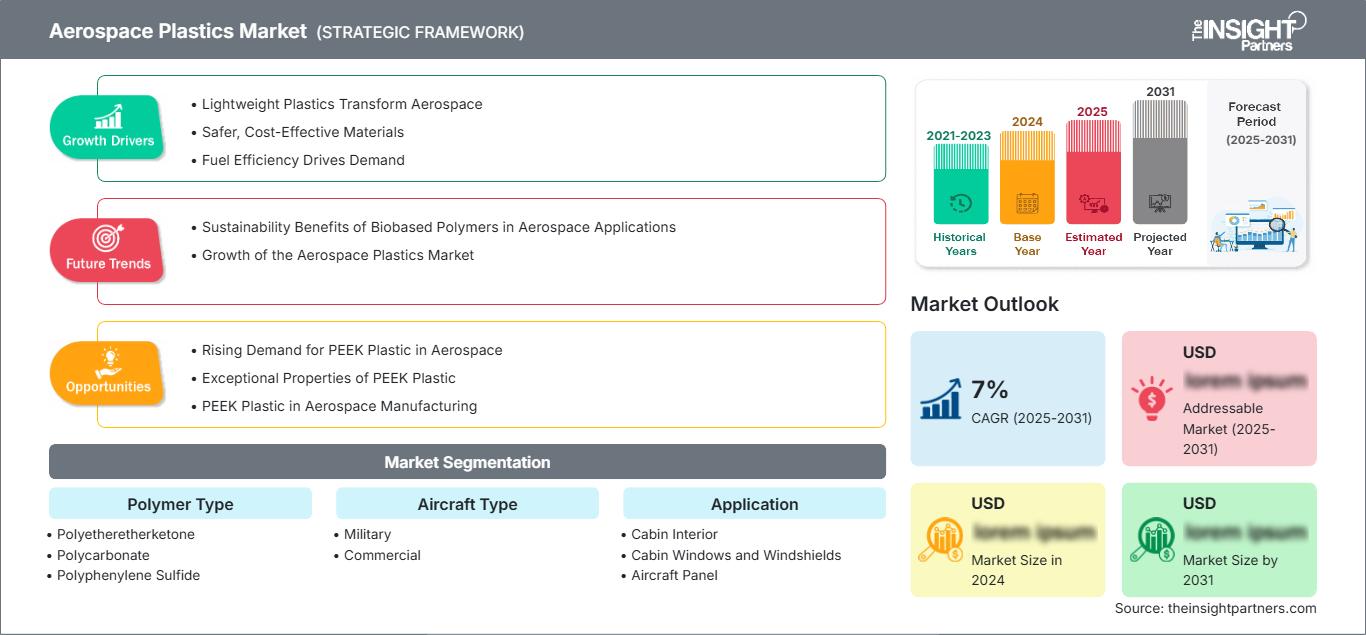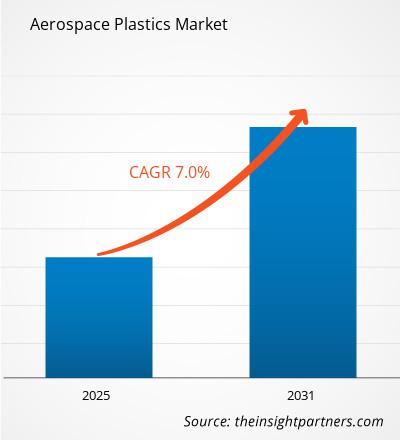Si prevede che il mercato delle materie plastiche aerospaziali registrerà un CAGR del 7% dal 2025 al 2031, con una dimensione del mercato in espansione da XX milioni di dollari nel 2024 a XX milioni di dollari entro il 2031.
Il rapporto sul mercato delle materie plastiche aerospaziali è segmentato per tipo di polimero (polietereterchetone, policarbonato, polifenilensolfuro, polieterimmide, polietersulfone, polimetilmetacrilato e altri). Il rapporto presenta inoltre un'analisi basata sul tipo di aeromobile (militare, commerciale e altri). Il rapporto è segmentato in base all'applicazione (interni della cabina, finestrini e parabrezza della cabina, pannelli dell'aeromobile e altri). L'analisi globale è ulteriormente suddivisa a livello regionale e per i principali paesi. Le dimensioni del mercato e le previsioni a livello globale, regionale e nazionale per tutti i principali segmenti di mercato sono trattate nell'ambito di applicazione. Il rapporto offre il valore in USD per l'analisi, i segmenti, le regioni e i paesi sopra indicati.
Scopo del rapporto
Il rapporto "Aerospace Plastics Market" di The Insight Partners mira a descrivere il panorama attuale e la crescita futura, i principali fattori trainanti, le sfide e le opportunità. Ciò fornirà spunti a vari stakeholder aziendali, come:
- Fornitori/Produttori di tecnologia: per comprendere le dinamiche di mercato in evoluzione e conoscere le potenziali opportunità di crescita, consentendo loro di prendere decisioni strategiche informate.
- Investitori: per condurre un'analisi completa delle tendenze in merito al tasso di crescita del mercato, alle proiezioni finanziarie di mercato e alle opportunità esistenti lungo la catena del valore.
- Enti di regolamentazione: per regolamentare le politiche e le attività di controllo sul mercato con l'obiettivo di ridurre al minimo gli abusi, preservare la fiducia degli investitori e sostenere l'integrità e la stabilità del mercato.
Segmentazione del mercato delle materie plastiche aerospaziali Tipo di polimero
- Polietereterchetone
- Policarbonato
- Polifenilensolfuro
- Polieterimmide
- Polietersulfone
- Polimetilmetacrilato
Tipo di aeromobile
- Militare
- Commerciale
Applicazione
- Interni della cabina
- Finestrini e parabrezza della cabina
- Pannelli dell'aeromobile
Geografia
- Nord America
- Europa
- Asia-Pacifico
- America meridionale e centrale
- Medio Oriente e Africa
Potrai personalizzare gratuitamente qualsiasi rapporto, comprese parti di questo rapporto, o analisi a livello di paese, pacchetto dati Excel, oltre a usufruire di grandi offerte e sconti per start-up e università
Mercato delle materie plastiche aerospaziali: Approfondimenti strategici

-
Ottieni le principali tendenze chiave del mercato di questo rapporto.Questo campione GRATUITO includerà l'analisi dei dati, che vanno dalle tendenze di mercato alle stime e alle previsioni.
Fattori di crescita del mercato delle materie plastiche aerospaziali
- Le materie plastiche leggere trasformano il settore aerospaziale: la crescente domanda di materiali leggeri nel settore aerospaziale sta trainando la crescita del mercato delle materie plastiche aerospaziali. Vi è una crescente domanda di materiali leggeri e durevoli, poiché i produttori di aeromobili devono realizzare componenti e parti più leggere per massimizzare l'efficienza del carburante.
- Materiali più sicuri ed economici: il settore aerospaziale considera anche la sicurezza e l'economicità, che i materiali leggeri possono offrire, aumentando ulteriormente l'adozione di materiali leggeri, come la plastica. La crescente necessità di materiali leggeri per la costruzione di componenti e parti aeronautiche ha aumentato significativamente la domanda di materie plastiche.
- L'efficienza del carburante stimola la domanda: i produttori di aeromobili si stanno impegnando per sviluppare enormi strutture termoplastiche primarie nei jet privati e negli aerei commerciali. Materiali come compositi e materie plastiche sono significativamente più leggeri di acciaio, ottone, leghe, ferro, ecc. L'utilizzo di questi materiali consente ai produttori di ridurre il peso delle parti degli aeromobili, facilitando di conseguenza la riduzione dei costi del carburante. Inoltre, l'adozione di materiali plastici nelle applicazioni di cabina è guidata da vantaggi in termini di leggerezza, economicità e sicurezza. I materiali plastici possono offrire un migliore isolamento e protezione per vari componenti all'interno dell'aeromobile, contribuendo alla sicurezza e all'efficienza complessive.
Tendenze future del mercato delle materie plastiche aerospaziali
- Vantaggi di sostenibilità dei polimeri biobased nelle applicazioni aerospaziali: i polimeri biobased offrono il vantaggio di ridurre la dipendenza dalle risorse di combustibili fossili e di ridurre le emissioni di gas serra. I materiali bioplastici sono utilizzati in componenti strutturali e non strutturali, materiali isolanti termici, materiali isolanti acustici, componenti di decorazione per interni e altri. I due materiali bioplastici maggiormente utilizzati nell'industria aerospaziale sono i polimeri rinforzati con fibre di lino (FFRP) e i compositi a base di micelio.
- Crescita del mercato delle materie plastiche aerospaziali: inoltre, con una domanda in continua crescita e un'innovazione continua, il mercato delle materie plastiche aerospaziali sta crescendo a un ritmo incredibile. L'industria aerospaziale si sta muovendo verso la sostenibilità e le bioplastiche rappresentano un'opzione in questo senso, grazie all'utilizzo di materiali più ecocompatibili rispetto alle plastiche convenzionali. Gli operatori del mercato si stanno inoltre concentrando sugli investimenti in attività di ricerca e sviluppo e sullo sviluppo e lancio di prodotti nuovi e innovativi per l'industria aerospaziale.
Opportunità di mercato per le materie plastiche aerospaziali
- Crescente domanda di plastica PEEK nel settore aerospaziale: si prevede che un'elevata domanda di plastica PEEK nel settore aerospaziale offrirà maggiori opportunità di crescita del mercato durante il periodo di previsione. La plastica PEEK è uno degli elementi essenziali per la moderna progettazione aerospaziale. Il PEEK è un termoplastico ingegneristico il cui rapporto resistenza/peso e la resistenza a temperature estreme e sostanze chimiche sono davvero eccezionali.
- Proprietà eccezionali della plastica PEEK: è una rivoluzione per le aziende aerospaziali trovare una plastica che le aiuti a costruire aeromobili più leggeri ed efficienti. La plastica PEEK è considerata adatta alla progettazione aerospaziale perché unisce rigidità, tenacità e resistenza termica a livelli eccezionalmente elevati rispetto a tutte le altre materie plastiche.
- Plastica PEEK nella produzione aerospaziale: la plastica PEEK è comunemente utilizzata nella produzione aerospaziale perché può ridurre il peso superfluo e al contempo resistere a temperature estreme, usura e corrosione. Questo ha portato gli ingegneri a utilizzarla come alternativa al metallo per ottimizzare le prestazioni in termini di efficienza del carburante, soprattutto nella produzione di motori e componenti strutturali.
Approfondimenti regionali sul mercato delle materie plastiche aerospaziali
Le tendenze regionali e i fattori che influenzano il mercato delle materie plastiche aerospaziali durante il periodo di previsione sono stati ampiamente spiegati dagli analisti di The Insight Partners. Questa sezione illustra anche i segmenti e la geografia del mercato delle materie plastiche aerospaziali in Nord America, Europa, Asia-Pacifico, Medio Oriente e Africa, America meridionale e centrale.
Ambito del rapporto sul mercato delle materie plastiche aerospaziali
| Attributo del rapporto | Dettagli |
|---|---|
| Dimensioni del mercato in 2024 | US$ XX million |
| Dimensioni del mercato per 2031 | US$ XX Million |
| CAGR globale (2025 - 2031) | 7% |
| Dati storici | 2021-2023 |
| Periodo di previsione | 2025-2031 |
| Segmenti coperti |
By Tipo di polimero
|
| Regioni e paesi coperti |
Nord America
|
| Leader di mercato e profili aziendali chiave |
|
Densità degli operatori del mercato delle materie plastiche aerospaziali: comprendere il suo impatto sulle dinamiche aziendali
Il mercato delle materie plastiche aerospaziali è in rapida crescita, trainato dalla crescente domanda degli utenti finali, dovuta a fattori quali l'evoluzione delle preferenze dei consumatori, i progressi tecnologici e una maggiore consapevolezza dei vantaggi del prodotto. Con l'aumento della domanda, le aziende stanno ampliando la propria offerta, innovando per soddisfare le esigenze dei consumatori e sfruttando le tendenze emergenti, alimentando ulteriormente la crescita del mercato.

- Ottieni il Mercato delle materie plastiche aerospaziali Panoramica dei principali attori chiave
Punti di forza
- Copertura completa: il rapporto analizza in modo esaustivo prodotti, servizi, tipologie e utenti finali del mercato delle materie plastiche aerospaziali, offrendo una panoramica olistica.
- Analisi degli esperti: il rapporto è redatto sulla base della conoscenza approfondita di esperti e analisti del settore.
- Informazioni aggiornate: il rapporto garantisce la pertinenza aziendale grazie alla copertura di informazioni e dati recenti.
- Opzioni di personalizzazione: questo rapporto può essere personalizzato per soddisfare le esigenze specifiche del cliente e adattarsi in modo appropriato alle strategie aziendali.
Il rapporto di ricerca sul mercato delle materie plastiche aerospaziali può quindi contribuire a guidare il percorso di decodificazione e comprensione dello scenario del settore e delle prospettive di crescita. Sebbene possano esserci alcune valide preoccupazioni, i vantaggi complessivi di questo rapporto tendono a superare gli svantaggi.
- Analisi storica (2 anni), anno base, previsione (7 anni) con CAGR
- Analisi PEST e SWOT
- Valore/volume delle dimensioni del mercato - Globale, Regionale, Nazionale
- Industria e panorama competitivo
- Set di dati Excel
Report recenti
Rapporti correlati
Testimonianze
Motivo dell'acquisto
- Processo decisionale informato
- Comprensione delle dinamiche di mercato
- Analisi competitiva
- Analisi dei clienti
- Previsioni di mercato
- Mitigazione del rischio
- Pianificazione strategica
- Giustificazione degli investimenti
- Identificazione dei mercati emergenti
- Miglioramento delle strategie di marketing
- Aumento dell'efficienza operativa
- Allineamento alle tendenze normative






















 Ottieni un campione gratuito per - Mercato delle materie plastiche aerospaziali
Ottieni un campione gratuito per - Mercato delle materie plastiche aerospaziali